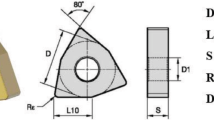Abstract
The longevity of hard alloy indexable cutting inserts used to cut metal parts is significantly related to their proper geometric design. Such a relationship is outstanding in an intermittent cutting scenario. One solution is to use a strengthened cutting insert with a negative chamfered edge. This method has proven to be effective in avoiding chipping and brittle fractures. However, it does have other effects, like a larger cutting force and a higher cutting heat. In the present research, a set of intermittent cutting experiments were conducted through combinations of two grades of hard alloy indexable inserts and multiple geometric parameters of cutting edges. A three-dimensional dynamometer and a high-speed camera were used to monitor and collect data on the impact and cutting force during the process. A study over the strengthening mechanism of the negative chamfer to the cutting insert was conducted using statistical analysis, which revealed the influence of those geometric parameters of cutting edges on the insert’s lifetime. Further, it gave a quantified relationship between the negative chamfer parameter and the feed. This conclusion serves as both data and technical support for the design enhancement of hard alloy indexable inserts.
Similar content being viewed by others
References
Gok A, Gok K (2014) The effect on the cemented carbide cutting tool of austempering process. Trans Indian Inst Metals 67(5):667–674. doi:10.1007/s12666-014-0389-4
Gok A, Gologlu C, Demirci H (2013) Cutting parameter and tool path style effects on cutting force and tool deflection in machining of convex and concave inclined surfaces. Int J Adv Manuf Technol 69(5–8):1063–1078. doi:10.1007/s00170-013-5075-x
Palani S, Natarajan U (2011) Prediction of surface roughness in CNC end milling by machine vision system using artificial neural network based on 2D Fourier transform. Int J Adv Manuf Technol 54(9–12):1033–1042. doi:10.1007/s00170-010-3018-3
Zhou Z, Xie SS, Chen D (2012) Fundamentals of digital manufacturing science. Springer London Ltd, London
Chen Y, Dong F (2013) Robot machining: recent development and future research issues. Int J Adv Manuf Technol 66(9–12):1489–1497. doi:10.1007/s00170-012-4433-4
Cheng X, Wang Z, Nakamoto K, Yamazaki K (2011) A study on the micro tooling for micro/nano milling. Int J Adv Manuf Technol 53(5–8):523–533. doi:10.1007/s00170-010-2856-3
Gok K, Sari H, Gok A, Neseli S, Turkes E, Yaldiz S (2015) Three-dimensional finite element modeling of effect on the cutting forces of rake angle and approach angle in milling. Proc Inst Mech Eng E J Proc Mech Eng. doi:10.1177/0954408915576698
Wu C, Nie H, Zhang S (2012) Study and development of materials for high-quality hardmetal tools. Tool Eng 72(1–4):521–530
Qiao Y, Ai X, Zhao J, Liu Z (2010) Study on technology and tool materials for high speed machining superalloy. Tool Eng 44(6):5–10
Li Q, Zhang W (2011) Study on the PCBN cutting tools properties during hardened steel machining. Diam Abras Eng 31(6):75–78
Devin LN, Stakhniv NE (2012) The study of the influence of wear of a cutting tool of CBN-based composite material on the tool fracture probability in the finish turning of hardened steels. J Superhard Mater 34(4):264–269
Deng Z, Liu Z, Zhang X (2010) Research of the science and technology development in high-speed and efficient processing field. J Mech Eng 46(23):106–120
Genghuang HEXL, Fugang YAN (2012) Research on the dynamic mechanical characteristics and turning tool life under the conditions of excessively heavy-duty turning. Front Mech Eng 7(3):329–334. doi:10.1007/s11465-012-0303-x
Zhang J, Huang X, Peng Q, Lu H (2011) Mechanism of intermittent cutting in gear milling. J Mech Eng 47(13):186–192
He G, Wu C, Liu X, Zhang S, Zou L (2015) Research on the damage behavior of the cemented carbide index-able insert in the intermittent cutting process. Diam Abras Eng 35(3):10–16
He G, Liu X, Yan F, Hu Q, Sun S, Liu L (2012) Research on the dynamic mechanical characteristics of the tool life in the excessively heavy-duty cutting process. Adv Mater Res 500:13–19
He G, Liu X, Yan F, Zhai Y, Zhao Z (2011) Research on the fracture and breakage of heavy-duty turning tool for rough machining hydrogenated cylindrical shell. Solid State Phenom 175:305–310
Liu X, Liu M, He G, Yan F, Cheng Y, Liu L (2014) Impact damage behavior of the cemented carbide insert in the heavy cutting process. J Mech Eng 50(23):175–185
Author information
Authors and Affiliations
Corresponding author
Rights and permissions
About this article
Cite this article
He, G., Liu, X., Wu, C. et al. Study on the negative chamfered edge and its influence on the indexable cutting insert’s lifetime and its strengthening mechanism. Int J Adv Manuf Technol 84, 1229–1237 (2016). https://doi.org/10.1007/s00170-015-7778-7
Received:
Accepted:
Published:
Issue Date:
DOI: https://doi.org/10.1007/s00170-015-7778-7



